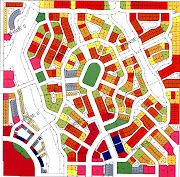Suburban cities are working with developers to create new town centers, many of them modeled after Celebration, Fla., developed by Walt Disney Co.
Urban planners say the best reason for creating a downtown is that it encourages commerce. "It's important because that's where retail's going. Shoppers want . . . an enjoyable social experience. They want to be in real places," says John Norquist, president and chief executive of Congress for the New Urbanism, a nonprofit group that encourages the building of such compact, pedestrian-friendly communities.
One of the challenges is the need to include affordable housing even though land costs are high. "Aside from diversity and all those wonderful things, no society works without some number of service workers," says David Smith, president of Recap Advisors, an affordable-housing consulting firm in Boston. "The closer they are to the jobs they do, the happier everybody is."
Another issue is that new downtowns seem contrived. Town-center designers are trying to combat that in part by hiring teams of architects so buildings aren’t all designed by one person and by selling lots separately rather than turning over large tracts to just one developer.
Source: Orlando Sentinel, Sandra Pedicini (02/12/07)
Tuesday, February 13, 2007
Suburbans Want More Urban
Saturday, February 10, 2007
"Miles per House" Bodes Well for the New Traditional Neighborhood
Click here to refresh: http://www.newherbanism.blogspot.com/
Look for “house miles” to become an important consideration in home purchases in coming years, say land-use experts who gathered for the Urban Land Institute’s recent meeting in Denver.
“A new generation of home buyers is looking at the world differently, and to them, green building will be a given," says John McIlwain, a senior resident fellow of ULI. "The issue of energy savings will be a fundamental driver in their decisions on what and where to buy." The cost of distance, along with heating and cooling, has a direct impact on housing affordability, McIlwain pointed out, noting that “miles per house” — the number of miles a home is from employment, retail, education, and entertainment — could become a standard measurement of location desirability.
A 2005 ULI survey of consumers found them willing to combine more trips and use mass transit more to cut down on fuel consumption, said Robert Dunphy, who's also a senior resident fellow of ULI. Transportation spending is the second largest component of consumer expenses, currently taking up an average of 19 percent of their monthly income (monthly home mortgage payments generally at least 33 percent).
As the cost of energy plays a more important role in home-buying decisions, house miles will become a deal breaker or maker. That trend will drive the development of sustainable housing and "green" communities. The land-use experts discussed some designs that are now gaining traction, such as close-in infill projects, more downtown housing, and more mixed-use projects in urban centers and on the urban fringe.
Source: Daily Real Estate News, by Camilla McLaughlin for REALTOR® Magazine Online
Monday, February 05, 2007
U.S. Homebuyers will Pay Premium for "Green" Homes
Click here to refresh: http://www.newherbanism.blogspot.com/
A survey released this week by Green Builder Media and Imre Communications reveals that U.S. homebuyers are willing to pay a premium for more environmentally friendly, green-built homes. The study surveyed more than 250 residential builders across the United States. A wide range of builders was included, from the affordable, market rate, luxury/semi-custom, custom, multi-family and developer categories.
More than half of homebuilders surveyed report that buyers are willing to pay a premium of between 11-25 percent for green-built homes. The same builders report that the average green homebuyer is between the ages of 35-50 with a college degree and a fair understanding of green products.
Source: Real Trends Newsletter, February 2, 2007
This is VERY good news for Traditional Neighborhood Development, because the same people who understand and value green building will understand and value the principles and benefits of living in a new traditional neighborhood.


